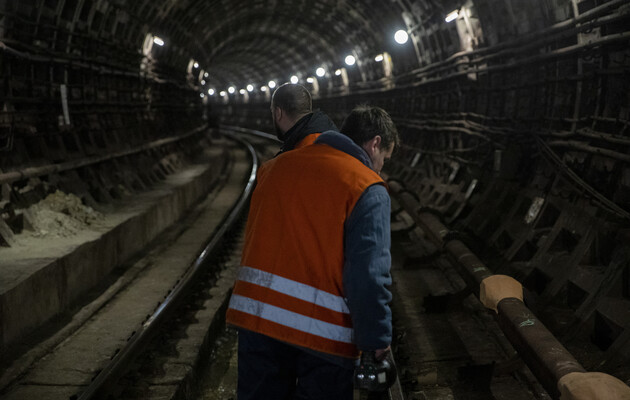A Stab in the Back. Who Destroyed the Subway on Teremky Neighborhood?

The closure of part of the blue line of the metro in the capital due to the flooding of the tunnel has rattled the media, social networks and corridors of power. Only the lazy ones, it would seem, have not participated in solving the problem: the Prime Minister of Ukraine has given an order, the Deputy Prime Minister has held a meeting, the Minister of Internal Affairs has emphasized its urgency, and the city prosecutor's office has initiated a pre-trial investigation. However, in this situation, it is important not to give banal recipes and not to look for culprits, but to investigate the reasons for making such an extraordinary decision as closing the subway.
This material is based on the information obtained during communication with Viktor Yanikin, a former director of the Kyivmetroproekt Institute, Viktor Vyhivskyi, the chief engineer of the Kyivskyi Metropoliten communal enterprise, and a circle of colleagues of Volodymyr Petrenko, a former general director of the Kyivmetrobud JSC.
A tunnel through geological ages
Cracks on the surface of the tunnel could have formed due to a number of subjective and objective factors. The first assumptions include poor-quality work of subway builders during the construction of the line, i.e., non-compliance with technologies, use of low-quality materials, etc., on the one hand, and deficiencies in operation by Kyivskyi Metropoliten communal enterprise, on the other. In this case, however, such phenomena should have manifested themselves on other metro lines, but during the 63 years of operation of the subway in Kyiv, there had been no accidents (thank God!), except for minor ones, and it was stopped only twice: for two days in 2014 during Euromaidan upon instructions of Volodymyr Makeienko (Chairman of the Kyiv City State Administration) and for two months in 2020 due to the quarantine caused by the Covid-19 pandemic.
Metro construction specialists name the reasons for the appearance of cracks in the frame of the tunnel, which led to the stoppage of the subway, but they are not limited to someone's negligence or mistakes during construction and operation - everything is much more complicated.
The crossing between the Lybidska and Demiivska stations is perhaps the most challenging in terms of construction and operation: it passes through the water-saturated soils of the Lybid stream bed. What’s more, the tunnel rises from the deep-lying level at Lybidska station to the shallow one at Demiivska station. Here it crosses the boundary between hard clay and soft sandy soils, i.e., at a distance of 250 meters, the 180-ton train takes an abrupt “leap” from a hard support to a soft one; it is on this place of the tunnel lining that the greatest loads fall and it is here that the fatal cracks appeared.
Did the designers realize this danger? Yes, which is why the diameter of the tunnel (and the thickness of the reinforced concrete tubing) was increased from 5100 to 5400 mm. In addition,“»siliconization” was carried out, that is, chemical strengthening of the external soils (although the latter does not protect against water seepage). Unfortunately, these measures did not provide full protection and the first cracks in the frame appeared three months after the tunnel was put into operation – in March 2011. The executor of the works, the Kyivmetrobud JSC, patched these cracks, and the tunnel... successfully stood still for 13 years, until the end of November of this year, when new cracks emerged and the emission of sand began.
The operators sounded the alarm and requested conclusions from the specialized institution – State Enterprise “State Scientific Research Institute of Building Structures,” which concluded: “Damage in the frame is characteristic of a situation where the stress-strain state changes, that is, there has been loosening or destruction of the soil of the space beyond the tunnel”, and went on to say: “The technical condition of the frame of the crossing tunnel along the first track between the Demiivska and Lybidska stations of the Obolon-Teremky subway line is classified as emergency (category “4”). Accordingly, the verdict: “Based on the requirements of the current norms, the operation of the 1st track on this section should be suspended.”
In view of this conclusion, the Permanent Commission on Technogenic Safety and Emergency Situations issued a decision to suspend the operation of part of the blue line.
Anthropogenic factors
These are mostly financial and economic. As a result of the 2008 economic crisis, from the end of 2008 to May 2010, all works on the blue line were stopped, the government discontinued funding, and the Kyivmetrobud JSC postponed the Holosiivska station until better times. In order to strengthen the external soils on the problem-fraught crossing, expensive chemicals were needed, for which there was no money. It was also possible to buy imported under-rail supports, but only for the critical section with a length of 250 meters, 1,000 pieces were needed for €500 each, that is, half a million euros, which, of course, were also not found.
During all this time, the Kyivskyi Metropoliten communal enterprise has not been in the best financial position. So, in 2020, during the coronavirus pandemic, due to a reduction in passenger traffic and a two-month stoppage, the cost of transporting one passenger increased to UAH 23 (!), with a fare being only UAH 8. Our government did dirty not only on the nurses of Kyiv hospitals, but also on the subway track service, when it closed the entrance to Kyiv to residents of the surrounding areas during the quarantine: 70% of the workers came to work in the subway at night from outside the city, so they were fired en masse and the work of this service was paralyzed, which includes, among other things, control over the condition of the tunnels.
For reference, in pre-coronavirus times, 5.5 million people arrived in Kyiv for work every day.
Kyiv: underground and above ground
There are about 700 surface water bodies in Kyiv. Under the city, there is an invisible but real underground sea of rivers, lakes, streams and springs... Because of this saturation of underground Kyiv with water, dozens of kilometers of underground tunnels stretch under the surface, through which water constantly flows. The Kyiv Specialized Department of Landslide Prevention has on its balance sheet 77.5 km of drainage tunnel systems, 10 km of shallow drains that no one from Kyiv, except diggers, has seen, and another 28 km of trays and open drains. Thus, we can say that Kyiv is an archipelago city.
Now imagine that into this invisible conglomerate of water, sand and clay thousands of concrete piles are driven, kilometers of retaining walls are cut and hundreds of thousands of tons of foundations are poured. If you look at the map, there are solid structures and construction sites along the route of the emergency section of the metro, starting with the famous Ocean Plaza shopping mall above the Lybidska station. Driving the Lybid river into a concrete channel does not mean that the problem of water drainage is solved, because its entire riverbed is saturated with springs and their water cannot get into the concrete banks! Therefore, any intervention in this system with piles and foundations only leads to a rise in the groundwater level, which, I believe, has led to the weakening of the soil under the tunnel and its subsequent destruction. So, the decisive anthropogenic factor that has brought about the closure of part of the blue line has the general name “Kyiv developer.”
Were there “severe consequences”?
Unfortunately, the discourse surrounding the issue of closing the metro in the capital immediately took on political overtones. The reasons for such close attention of the central authorities are clear: 200,000 residents of Teremky neighborhood, who suddenly found themselves without convenient and reliable connections with the center and other areas of the city, are a potential electorate. Here, the approaches of the state and city authorities turned out to be quite different. At a meeting of the State Commission on Emergency Situations, it was decided to use the frozen metro stations as bomb shelters, something even a child could think of.
Instead, the Kyiv City State Administration acted on a practical level. On December 8, 55 buses and 15 trolleys were already working between the Teremky and Lybidska stations, and on the first working day, their number increased even more. Judging by the crowd on Lybidska Street (the photo went viral on social media), this is still a challenge for the local authorities.
The city prosecutor's office reported on its Facebook page (not on the official website) that “a pre-trial investigation has been launched into the fact of neglect of duty, which has caused severe consequences (Part 2 of Article 367 of the Criminal Code of Ukraine).”
Here it is worth clarifying that this article refers specifically to officials who are assigned duties by a certain regulatory act; the improper performance of other, non-official, for example, purely professional, duties cannot be considered neglect of duty. In other words, there are no complaints against the subway builders or the subway workers, they can only be against the officials of the Kyivskyi Metropoliten communal enterprise and the Kyiv City State Administration, who “allowed” cracks and water to flow into the tunnel... It is not clear what “severe consequences” occurred, if as a result stoppage of trains in the metro, there were no destructions or casualties. Does the prosecutor's office believe that the transfer of passengers to buses and trolleybuses equals “severe consequences”?
At the same time, it is obvious that the closure of a part of the blue line has put the citizens of Kyiv and the city authorities in a precarious situation, which requires revision and improvement of the entire road and transport network of Kyiv. What should be done: let the flow of passengers go towards Sviatoshyn neighborhood, to the high-speed tram and the Akademmistechko station, or direct them along Vasylkivska and Holosiivska avenues? The city government should answer these questions in the coming days, but this is a topic for a separate analysis.
As of now, when asked whether it is realistic to restore the subway in six months, the chief engineer of Kyivskyi Metropoliten Viktor Vyhivskyi gave a clear answer: “We have set ourselves such a task.”
Read this article in Ukrainian and russian.
Please select it with the mouse and press Ctrl+Enter or Submit a bug











.jpg)
.jpg)
 Login with Google
Login with Google